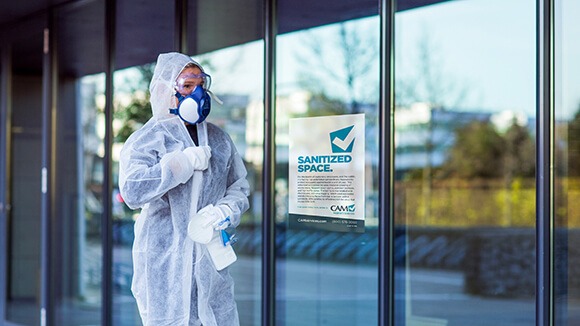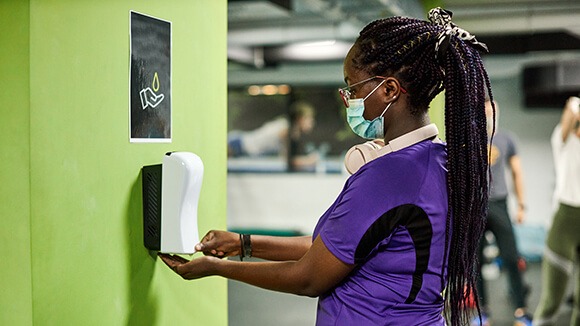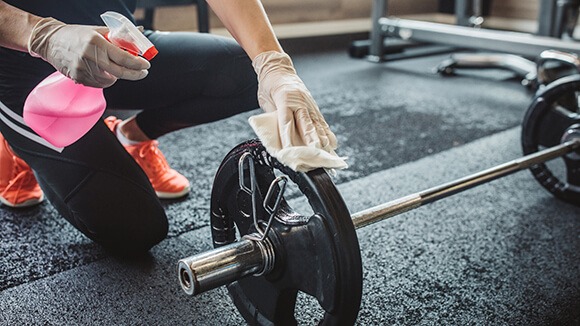Share This Story, Choose Your Platform!
Reimagined: Fitness Centers
As restricted businesses move toward reopening, normal operations are being altered to address heightened public health and safety concerns. The reopening of fitness centers is high on the list of those requiring modifications. Managers will need to implement plans for enhanced hygiene and social distancing, especially as indoor usage increases.
Operators have been asked to provide answers to questions such as:
- What are the social distancing rules for gyms?
- How to modify fitness center floorplans for social distancing?
- How are gyms disinfecting against COVID-19?
- How to avoid infection at a gym?
Fitness centers will need to quickly enhance disinfecting protocols, control customer flow, prevent gatherings, and effectively communicate new protocols to employees and customers.
To address these issues, you might want to consult with an Environmental Health and Safety (EHS) specialist trained in the latest safety recommendations, poised to evaluate fitness equipment, facility usage, and emerging technologies.
We caught up recently with Pranav Heryani, the EHS specialist for CAM Property Services, and got his input on important areas for fitness centers to address as they being to reopen in California. Heryani feels that companies must commit to an educated approach to safety and cleaning, including staff accountability. Earning and keeping consumer confidence will be key factors as businesses move forward. Here are some of his detailed suggestions to follow.
Occupancy Levels
Using CDC recommendations, the ideal occupancy level for any facility can be easily calculated. Imagine a 6-foot circle safety zone for each customer or employee. This circle has an area of 113 sq ft. Divide the area of each room in the gym by this number to determine the safe occupancy level of that room.
Social Distancing Measures
Aligning social distancing measures with existing fitness center floor plans requires a systematic strategy. If spacing is not an option, closing off alternating pieces of equipment is the next best thing. The minimum safe distance between operable equipment is six feet.
While cardiovascular and weight equipment have typically been grouped by function, it may be necessary to reconsider equipment groupings and layout to achieve safe distances for improved customer safety.
Locker rooms are a major area that must be considered. It is recommended that larger shower facilities close every other shower to achieve safe distancing. Lockers must also be spread out with alternate spacing. While layouts vary by facility, be sure to evaluate subjectively or consult a qualified professional. Smaller locker facilities may need to close altogether during this time.



An Educated Approach to Cleaning
Appropriate cleaning and disinfecting measures are vital to every operating plan. The good news is that cleanliness has always been a major consideration at fitness centers. Adopting and sticking to a rigid routine is essential. Constant cleaning throughout the day is reassuring to customers and contributes to a safe environment.
However, there is a difference between cleaning and disinfecting. Cleaning involves the physical method of removing dirt and impurities, which mitigates the risk of spread but does not eliminate it. Disinfecting is the killing or elimination of harmful pathogens. Regimens must include protocols and solvents that can accomplish cleaning and disinfecting. An outside property service may be better equipped to provide disinfection on an on-going basis.
Fitness centers are a unique environment featuring non-porous surfaces (metal equipment and mirrors), porous surfaces (rubber mats, grips, and upholstery), and electronic display screens (cardio equipment).
You must consider a wide-ranging list of effective solvents for different surfaces or risk damaging them. One disinfectant is unlikely to be suitable for all surfaces. Assess all surface types in your facility and acquire multi-purpose solutions or products formulated specifically for fitness equipment.
The application of these cleaning agents is equally important. Facilities must correctly apply products and allow them to remain on surfaces for the recommended duration in order to kill viruses effectively. Anti-virus fogging is also a viable solution implemented regularly to sanitize high-touch surfaces.
Supplies
Once protocols have been defined and a regimen is created, supplies must be adequately stocked. This includes personal hygiene products for members along with personal protective equipment (PPE) and solvents for employees.
As cleaning products continue to remain in high demand, a business may benefit by contracting with an outside property service that has strong relationships with key suppliers to ensure access to steady supplies.
Routine and Scheduling
Traditionally, it has been acceptable to clean fitness centers prior to opening and after the closing of the facility, with spot cleaning following peak usage. This must change in the current climate. Detailed cleaning and disinfecting must be performed before, during, and after business hours. Members will appreciate efforts taken by management to ensure their health and safety.
Incident Response
Even in the cleanest environments, a random viral incident can occur. Swiftly, decisively, and transparently addressing the situation can make a huge difference. Third-party intervention is often necessary for providing a commercial grade incident response with high visibility and a credentialed response unit. Maintaining consumer confidence will be critical in the business climate ahead of us.
Greatest Member Concerns About Returning To The Gym
Throughout the pandemic, fitness centers have been declared high risk facilities for viral outbreaks and spreading. Facilities must take extraordinary measures to assuage concerns and combat the prevailing public opinion.
Action Steps
While your in-house team may be qualified under normal conditions, a third-party option should be considered to enhance facility services.
In California, for example, CAM Property Services has specialists that have Global Biorisk Advisory Council (GBAC) certification, EHS training, and 34 years of commercial property experience. They can help craft your tailor-made fitness center re-opening plan.
Their professional facility team can deliver a socially distanced floorplan, implement state-of-the-art disinfecting measures, establish occupancy threshold guidance, and incorporate futurist business ideas that align with your company’s goals.
Whatever direction you choose, please take steps to mitigate the risk of COVID-19 for the health and safety of all.
About The Subject Matter Expert: Pranav Heryani is an EHS & Sustainability Specialist. Among the next generation of environmental professionals, his projects have encompassed both local and international efforts toward green initiatives with practical sustainability for the commercial sector.
